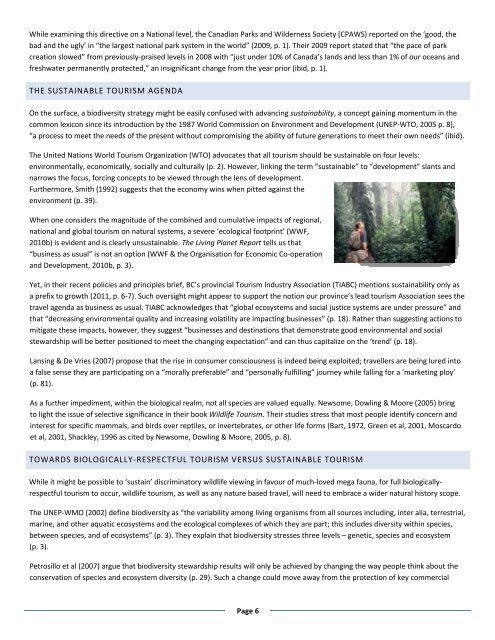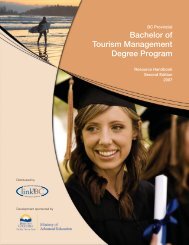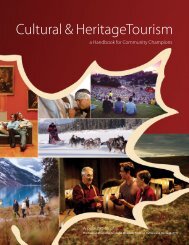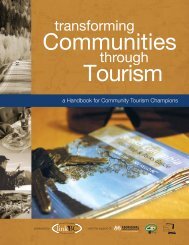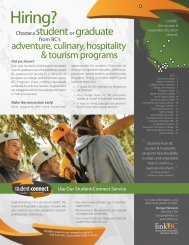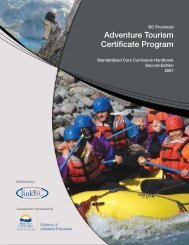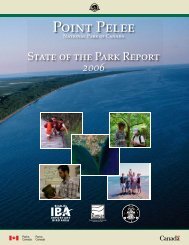Biologically-Respectful Tourism - LinkBC
Biologically-Respectful Tourism - LinkBC
Biologically-Respectful Tourism - LinkBC
You also want an ePaper? Increase the reach of your titles
YUMPU automatically turns print PDFs into web optimized ePapers that Google loves.
While examining this directive on a National level, the Canadian Parks and Wilderness Society (CPAWS) reported on the ‘good, the<br />
bad and the ugly’ in “the largest national park system in the world” (2009, p. 1). Their 2009 report stated that “the pace of park<br />
creation slowed” from previously‐praised levels in 2008 with “just under 10% of Canada’s lands and less than 1% of our oceans and<br />
freshwater permanently protected,” an insignificant change from the year prior (ibid, p. 1).<br />
THE SUSTAINABLE TOURISM AGENDA<br />
On the surface, a biodiversity strategy might be easily confused with advancing sustainability, a concept gaining momentum in the<br />
common lexicon since its introduction by the 1987 World Commission on Environment and Development (UNEP‐WTO, 2005 p. 8),<br />
“a process to meet the needs of the present without compromising the ability of future generations to meet their own needs” (ibid).<br />
The United Nations World <strong>Tourism</strong> Organization (WTO) advocates that all tourism should be sustainable on four levels:<br />
environmentally, economically, socially and culturally (p. 2). However, linking the term “sustainable” to “development” slants and<br />
narrows the focus, forcing concepts to be viewed through the lens of development.<br />
Furthermore, Smith (1992) suggests that the economy wins when pitted against the<br />
environment (p. 39).<br />
When one considers the magnitude of the combined and cumulative impacts of regional,<br />
national and global tourism on natural systems, a severe ‘ecological footprint’ (WWF,<br />
2010b) is evident and is clearly unsustainable. The Living Planet Report tells us that<br />
“business as usual” is not an option (WWF & the Organisation for Economic Co‐operation<br />
and Development, 2010b, p. 3).<br />
Yet, in their recent policies and principles brief, BC’s provincial <strong>Tourism</strong> Industry Association (TIABC) mentions sustainability only as<br />
a prefix to growth (2011, p. 6‐7). Such oversight might appear to support the notion our province’s lead tourism Association sees the<br />
travel agenda as business as usual. TIABC acknowledges that “global ecosystems and social justice systems are under pressure” and<br />
that “decreasing environmental quality and increasing volatility are impacting businesses” (p. 18). Rather than suggesting actions to<br />
mitigate these impacts, however, they suggest “businesses and destinations that demonstrate good environmental and social<br />
stewardship will be better positioned to meet the changing expectation” and can thus capitalize on the ‘trend’ (p. 18).<br />
Lansing & De Vries (2007) propose that the rise in consumer consciousness is indeed being exploited; travellers are being lured into<br />
a false sense they are participating on a “morally preferable” and “personally fulfilling” journey while falling for a ‘marketing ploy’<br />
(p. 81).<br />
As a further impediment, within the biological realm, not all species are valued equally. Newsome, Dowling & Moore (2005) bring<br />
to light the issue of selective significance in their book Wildlife <strong>Tourism</strong>. Their studies stress that most people identify concern and<br />
interest for specific mammals, and birds over reptiles, or invertebrates, or other life forms (Bart, 1972, Green et al, 2001, Moscardo<br />
et al, 2001, Shackley, 1996 as cited by Newsome, Dowling & Moore, 2005, p. 8).<br />
TOWARDS BIOLOGICALLY‐RESPECTFUL TOURISM VERSUS SUSTAINABLE TOURISM<br />
While it might be possible to ‘sustain’ discriminatory wildlife viewing in favour of much‐loved mega fauna, for full biologicallyrespectful<br />
tourism to occur, wildlife tourism, as well as any nature based travel, will need to embrace a wider natural history scope.<br />
The UNEP‐WMO (2002) define biodiversity as “the variability among living organisms from all sources including, inter alia, terrestrial,<br />
marine, and other aquatic ecosystems and the ecological complexes of which they are part; this includes diversity within species,<br />
between species, and of ecosystems” (p. 3). They explain that biodiversity stresses three levels – genetic, species and ecosystem<br />
(p. 3).<br />
Petrosillo et al (2007) argue that biodiversity stewardship results will only be achieved by changing the way people think about the<br />
conservation of species and ecosystem diversity (p. 29). Such a change could move away from the protection of key commercial<br />
Page 6


